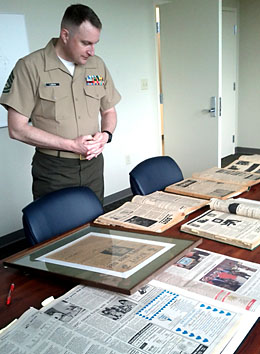Parris Island’s “The Boot” folds

Gunnery Sgt. Bill Lisbon, the Marine Corps Recruit Depot Parris Island public affairs chief, pages over old copies of “The Boot” Friday afternoon. Photo by Erin Moody/Beaufort Gazette.
Published: April 21, 2013
By Erin Moody — emoody@beaufortgazette.com
PARRIS ISLAND — You can sense Jack Paxton’s grin even across the phone as he describes how “Iron Mike” once delivered news to the Marines of Parris Island.
“Every Monday, I would be called to the general’s office, and they would kind of hint what they wanted to see in The Boot,” he said.
And occasionally, the “As I See It” column Paxton wrote using Iron Mike as a pseudonym – taken from the famed statue on the Marine Recruit Depot – would reflect those talks with higher-ups. The retired captain is convinced that might have earned him at least one promotion.
But after 70 years, The Boot, the base newspaper, printed its last edition April 12. Paxton, now executive director of the U.S. Marine Corps Combat Correspondents Association and Foundation, called the decision disappointing but not unexpected.
The Jetstream, published by the Marine Corps Air Station Beaufort, will continue.
Paxton recalled the old days of publishing The Boot, in the late-1950s, when the newspaper was assembled at The Beaufort Gazette office. He helped lay out the paper to get it ready for publication each Friday.
Paxton said he and “this pink-cheeked young kid” who came to Parris Island from Okinawa would “fight like hell” as they produced the newspaper of record. He still stays in touch with that former first lieutenant – Jim Lehrer, of PBS’ “News Hour” fame.
Lehrer remembers the experience fondly.“I had come to PI from 14 months with an infantry battalion in the Far East and wanted to work with recruits as a serial officer,” Lehrer wrote in an email Friday. “But the colonel in charge of assignments at PI saw that I had a journalism degree and to The Boot I went.”
He was the officer in charge for about six months in 1959 and said his main jobs were writing editorials and fetching the printed paper from Savannah with Paxton. His most memorable editorial criticized Marine parents for their conduct at Little League games.
The Boot was first published in 1943 and traces its roots to journalists the Marine Corps recruited to go through boot camp and embed in combat in World War II, according to Parris Island public affairs chief, Gunnery Sgt. Bill Lisbon.
Combat correspondents and public-affairs roles have changed over the years, but one thing has remained.
“That’s always been our job, since 1942: tell the Marine Corps’ story, one way or another,” Lisbon said.
The Boot’s coverage has run the gamut. Community announcements were a staple, and it has published pinup girls. It covered the Ribbon Creek incident in 1956, in which six recruits died after being marched into the marsh.
The July 27, 1956, edition included an article on the return of campaign hats, which drill instructors are infamous for wearing.
“Incidentally, there will be a drop off in the amount of sunburn lotions bought at the PX,” the writer noted.
The end of The Boot is not spurred by sequestration or military budget cuts, Lisbon said. Rather, the change was made to allow staff to focus on providing immediate information about what is going on at the recruit depot to a larger online audience.
“We think what we’re doing is great, so we want to let them know, ‘Hey, this is what we’re doing with your sons and daughters and for your nation,’” he said.
That transition has been underway for about a year and a half, as public-affairs staff has ramped up online efforts, especially on Facebook. “Newsier” information will be distributed through the Defense Video & Imagery Distribution System wire service the military uses.
One of the strongest arguments for keeping The Boot was its role as a memento for parents and graduates, but those names are printed in The Beaufort Gazette and other publications and are available as souvenirs, too, Lisbon said.
The end is still bittersweet for Lisbon, who served brief stints at the paper when he got out of boot camp and again in the late 1990s.
“I remember when I was laying out the paper – ’97 probably. The computers were kind of slow, and I was a perfectionist about it, so I would stay up all night,” he said. “I had a 40-hour day, not a 40-hour week.”